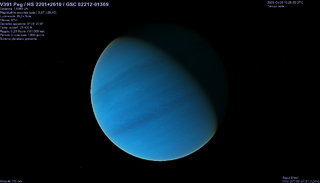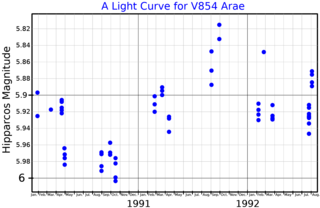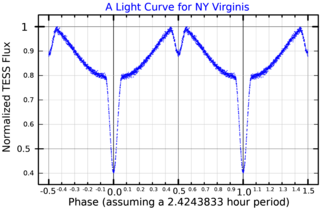
Pegasus is a constellation in the northern sky, named after the winged horse Pegasus in Greek mythology. It was one of the 48 constellations listed by the 2nd-century astronomer Ptolemy, and is one of the 88 constellations recognised today.

28 Aquilae, abbreviated 28 Aql, is a star in the equatorial constellation of Aquila. 28 Aquilae is its Flamsteed designation though it also bears the Bayer designation A Aquilae, and the variable star designation V1208 Aquilae. It has an apparent visual magnitude is 5.5, making this a faint star that requires dark suburban skies to view. The annual parallax shift of 9.6 mas means this star is located at a distance of approximately 340 light-years from Earth.

9 Aurigae is a star system in Auriga (constellation). It has an apparent magnitude of about 5, making it visible to the naked eye in many suburban skies. Parallax estimates made by the Hipparcos spacecraft put it at about 86 light-years from the solar system, although individual Gaia Data Release 3 parallaxes place all three components at 88 light years.

Tau Pegasi, formally named Salm, is a magnitude 4.6 star 162 light years away in the constellation of Pegasus. With about twice the mass of the Sun and thirty times as luminous, it is a δ Scuti variable star with its brightness changing by a few hundredths of a magnitude over about an hour.

31 Vulpeculae is a binary star system in the northern constellation of Vulpecula. It is visible to the naked eye as a faint, yellow-hued point of light with an apparent visual magnitude of 4.56. The system is located approximately 228 light years away from the Sun based on parallax, and it is drifting further away with a radial velocity of +2.25 km/s.

V391 Pegasi b, also known as HS 2201+2610 b, is an extrasolar planet candidate orbiting the star V391 Pegasi approximately 4,570 light-years away in the constellation of Pegasus. The candidate planet was discovered by means of variable star timing, which measured anomalies in variability of the star caused by a planet. It is the first planet candidate to claim to be detected with this method. The discovery reported the planet candidate to have mass of 3.2 times Jupiter's, semi-major axis of 1.7 AU, and orbital period of 1,170 days.

A B-type subdwarf (sdB) is a kind of subdwarf star with spectral type B. They differ from the typical subdwarf by being much hotter and brighter. They are situated at the "extreme horizontal branch" of the Hertzsprung–Russell diagram. Masses of these stars are around 0.5 solar masses, and they contain only about 1% hydrogen, with the rest being helium. Their radius is from 0.15 to 0.25 solar radii, and their surface temperature is from 20,000 to 40,000 K.
HD 97048 or CU Chamaeleontis is a Herbig Ae/Be star 603 ly away in the constellation Chamaeleon. It is a variable star embedded in a dust cloud containing a stellar nursery, and is itself surrounded by a dust disk.

HW Virginis, abbreviated HW Vir, is an eclipsing binary system, approximately 563 light-years away based on the parallax measured by the Gaia spacecraft, in the constellation of Virgo. The system comprises an eclipsing B-type subdwarf star and red dwarf star. The two stars orbit each other every 0.116795 days.

HD 155035 is a star in the constellation Ara, the Altar. It is located at a distance of approximately 1,450 light-years from Earth and has an apparent visual magnitude of 5.92, making it is faintly visible to the naked eye. This is a red giant star with a stellar classification of M1.5 III.

KPD 1930+2752 is a binary star system including a subdwarf B star and a probable white dwarf with relatively high mass. Due to the nature of this astronomical system, it seems like a likely candidate for a potential type Ia supernova, a type of supernova which occurs when a white dwarf star takes on enough matter to approach the Chandrasekhar limit, the point at which electron degeneracy pressure would not be enough to support its mass. However, carbon fusion would occur before this limit was reached, releasing enough energy to overcome the force of gravity holding the star together and resulting in a supernova.

Psi Pegasi, which is Latinized from ψ Pegasi, is a binary star system within the great square in the northern constellation of Pegasus. It has a red hue and is faintly visible to the naked eye with an apparent visual magnitude of 4.66. This object is located at a distance of approximately 476 light-years away from the Sun based on parallax, but is drifting closer with a radial velocity of −6.6 km/s.

ν Pegasi, Latinized as Nu Pegasi is a single star in the northern constellation of Pegasus. It is an orange-hued star that is faintly visible to the naked eye with an apparent visual magnitude of 4.84. The star is located approximately 261 light years away based on parallax, but is drifting closer with a radial velocity of −19 km/s.

AG Pegasi is a symbiotic binary star in the constellation Pegasus. It is a close binary composed of a red giant and white dwarf, estimated to be around 2.5 and 0.6 times the mass of the Sun respectively. It is classified as a symbiotic nova; it has undergone one extremely slow nova outburst and a smaller outburst.
EQ Pegasi is a nearby binary system of two red dwarfs. Both components are flare stars, with spectral types of M4Ve and M6Ve respectively, and a current separation between the components of 5.8 arcseconds. The system is at a distance of 20.4 light-years, and is 950 million years old. The primary star is orbited by one known exoplanet.
Kepler-451 is an eclipsing post-common envelope binary star system that comprises two stars, a pulsating subdwarf B star and a small red dwarf star. It is located about 1,340 light-years away in the constellation Cygnus. It has been hypothesized to host one or more exoplanets.

S Cassiopeiae is a Mira variable and S-type star in the constellation Cassiopeia. It is an unusually cool star, rapidly losing mass and surrounded by dense gas and dust producing masers.

LS IV-14 116 is a hot subdwarf located approximately 2,000 light years away on the border between the constellations Capricornus and Aquarius. It has a surface temperature of approximately 34,000 ± 500 kelvins. Along with stars HE 2359-2844 and HE 1256-2738, LS IV-14 116 forms a new group of star called heavy metal subdwarfs. These are thought to be stars contracting to the extended horizontal branch after a helium flash and ejection of their atmospheres at the tip of the red giant branch.

NY Virginis is a binary star about 1,940 light-years away. The primary belongs to the rare class of subdwarf B stars, being former red giants with their hydrogen envelope completely stripped by a stellar companion. The companion is a red dwarf star. The binary nature of NY Virginis was first identified in 1998, and the extremely short orbital period of 0.101016 d, together with brightness variability on the timescale of 200 seconds was noticed, resulting in the identification of the primary star as a B-type subdwarf in 2003. Under a proposed classification scheme for hot subdwarfs it would be class sdB1VII:He1. This non-standard system indicates that it is a "normal" luminosity for a hot subdwarf and that the spectrum is dominated by hydrogen rather than helium.
Kepler-429 is a variable subdwarf B star in the constellation Lyra, about 5,900 light years away.














